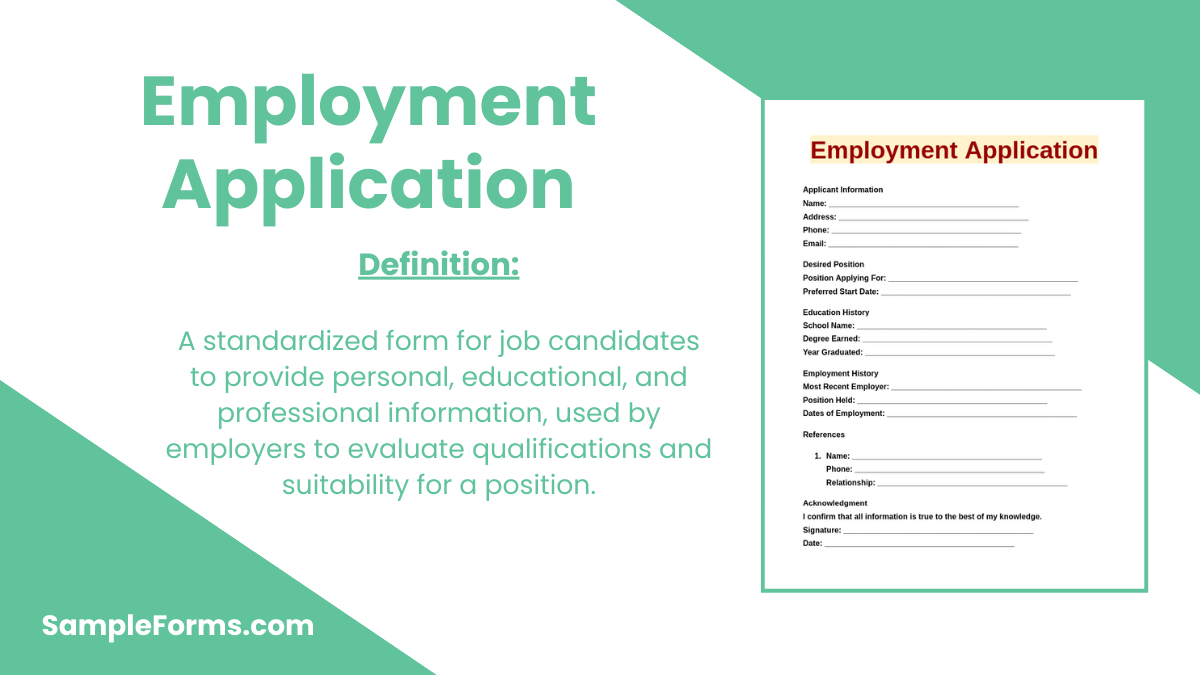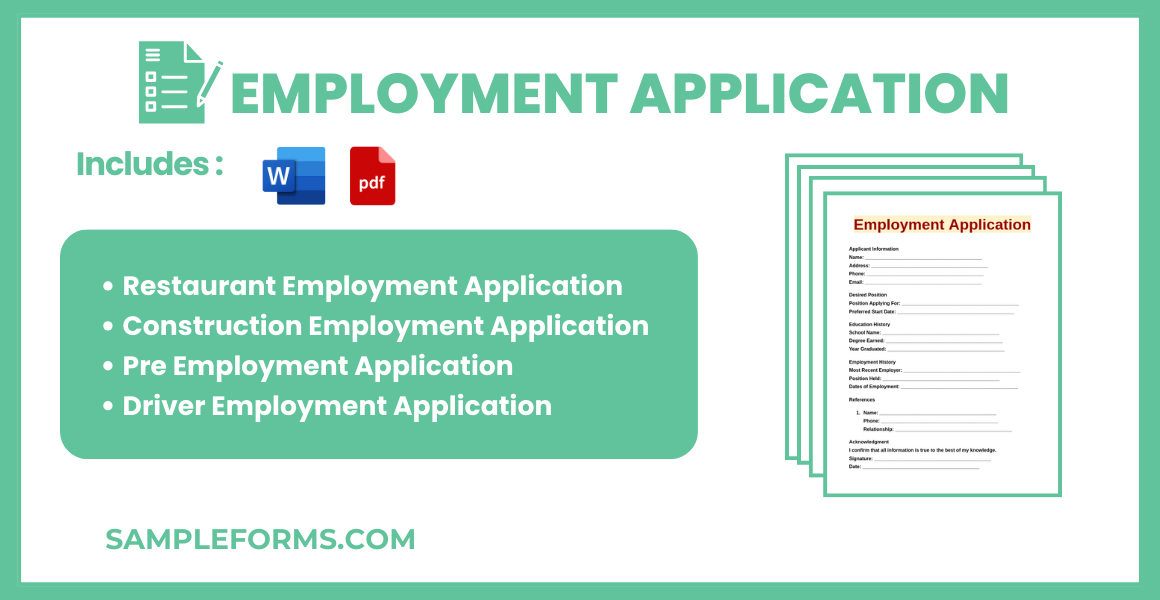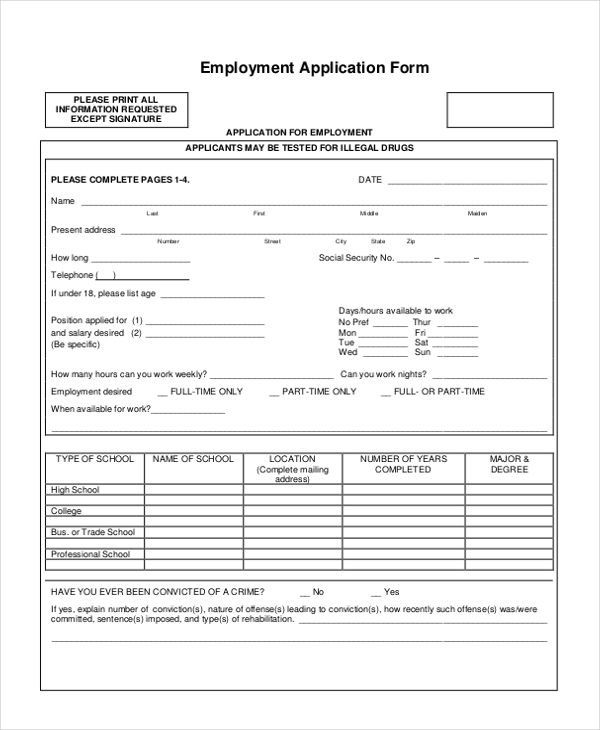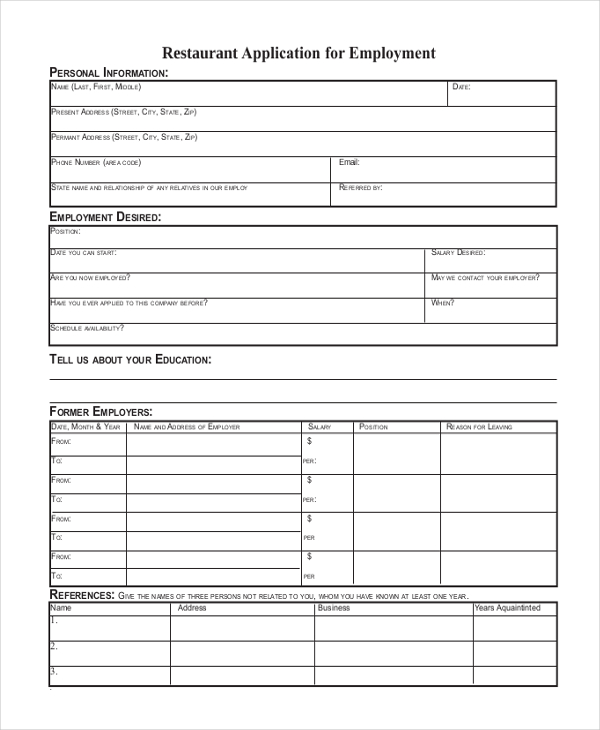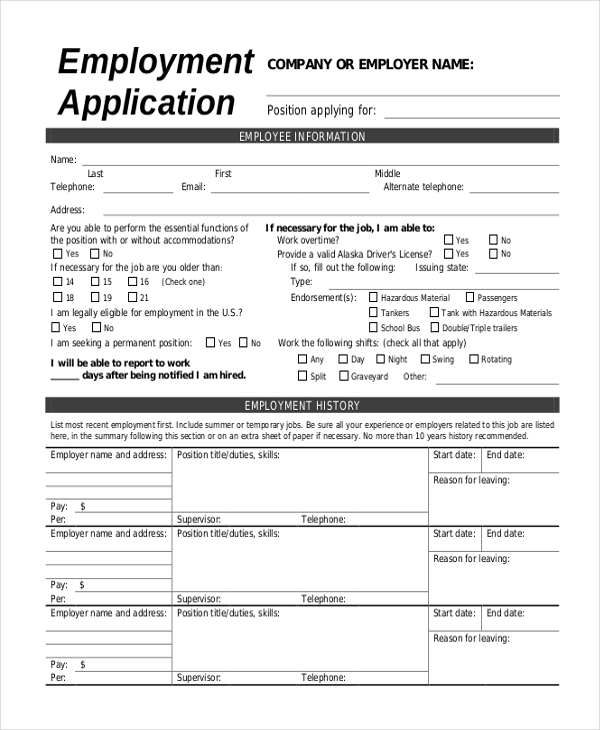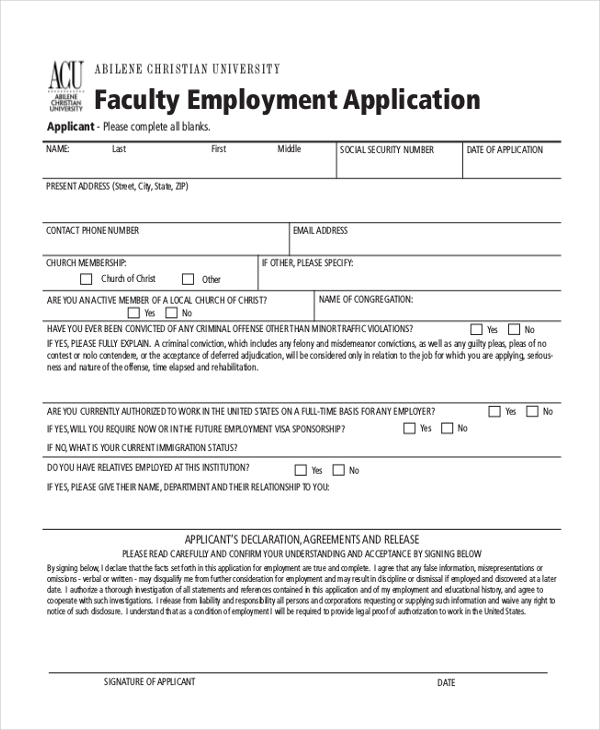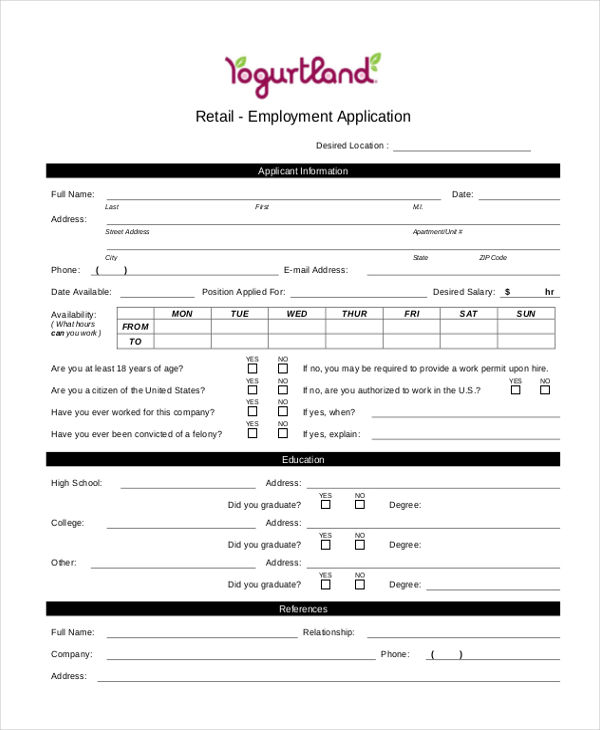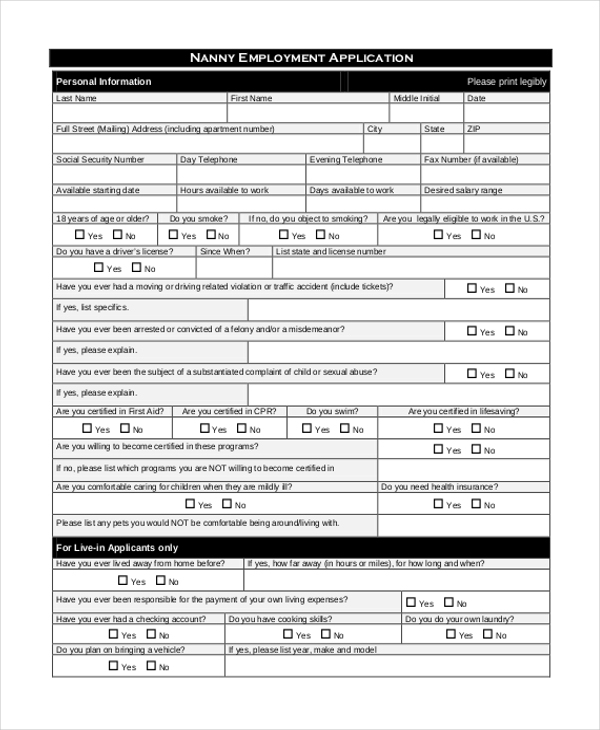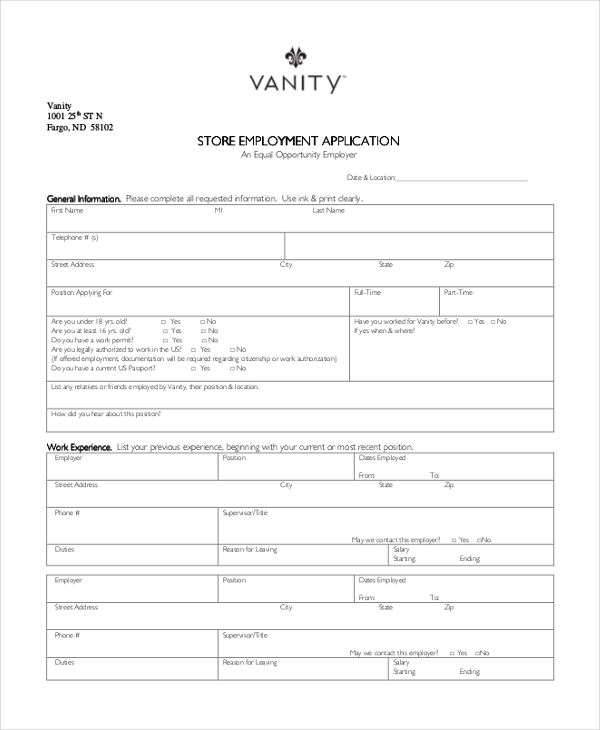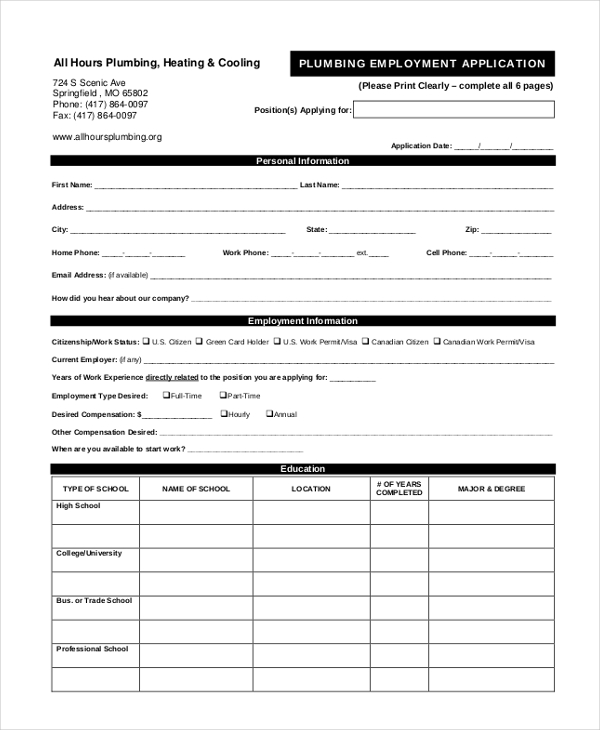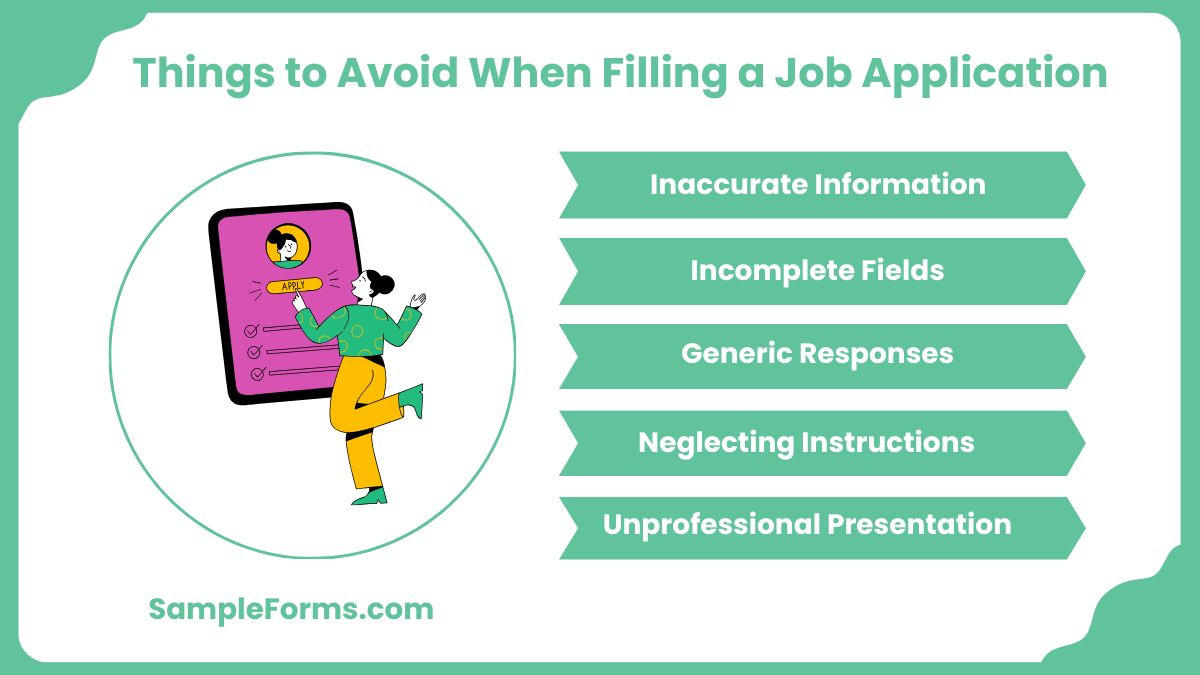An Employment Application is a vital document for streamlining the hiring process and gathering essential candidate information. This guide explores the importance of an Employment Form and how it ensures compliance, efficiency, and informed hiring decisions. Whether you’re hiring for retail, construction, or corporate roles, using a structured Application Form simplifies evaluation and fosters professionalism. From essential components to practical examples, this comprehensive resource provides everything needed to create tailored forms. Leverage this guide to optimize your recruitment workflow and build a robust talent pipeline while ensuring legal compliance and clarity in documentation.
Download Employment Application Bundle
What is Employment Application?
An Employment Application is a standardized form used by employers to collect essential information about candidates during the hiring process. It includes details such as personal information, employment history, educational background, and references. This document helps employers evaluate applicants’ qualifications and ensures consistency in the hiring process. By using an application, organizations can streamline recruitment and maintain accurate records for compliance and decision-making.
Employment Application Format
Applicant Information
Full Name: ______________________________________________________
Date of Birth: __________________________________________________
Contact Number: ________________________________________________
Email Address: _________________________________________________
Address: _______________________________________________________
Educational Background
Highest Degree Obtained: ________________________________________
Institution Name: _______________________________________________
Graduation Year: ________________________________________________
Additional Certifications: _______________________________________
Work Experience
Employer 1: ____________________________________________________
Position Held: _________________________________________________
Duration: ______________________________________________________
Key Responsibilities: ___________________________________________
Employer 2: ____________________________________________________
Position Held: _________________________________________________
Duration: ______________________________________________________
Key Responsibilities: ___________________________________________
References
Reference Name: ________________________________________________
Contact Information: ____________________________________________
Relationship: _________________________________________________
Declaration
I affirm that the information provided is accurate to the best of my knowledge.
Applicant Signature: ________________________ Date: ______________
Restaurant Employment Application
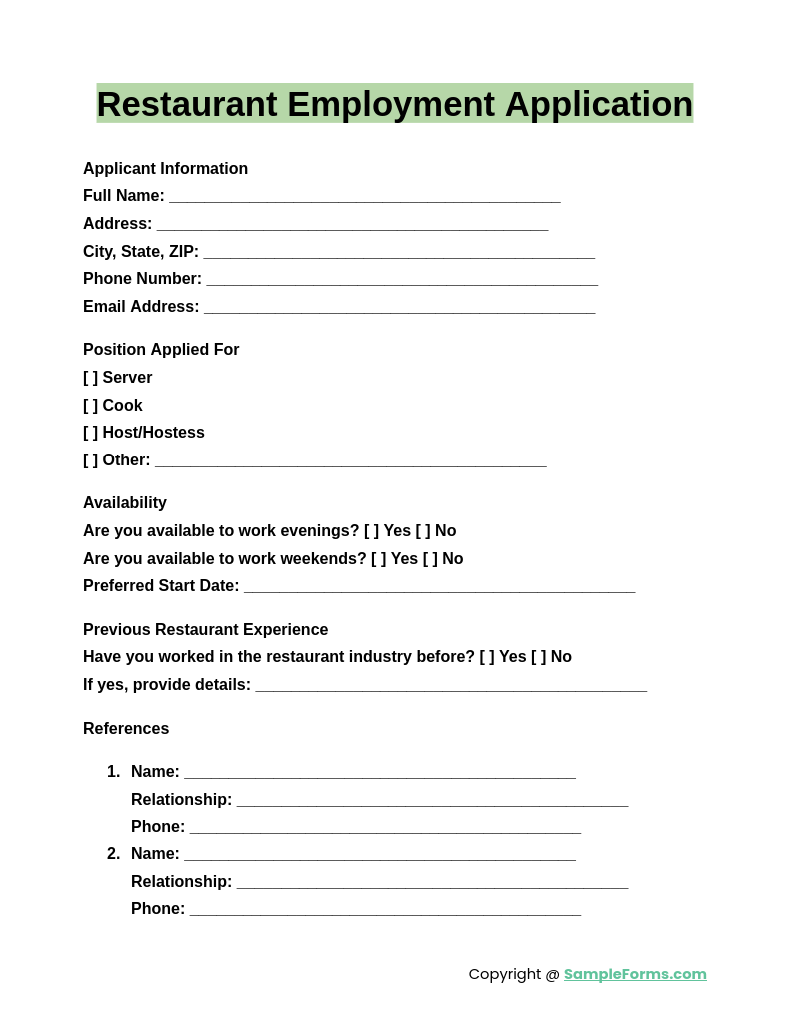
A Restaurant Employment Application gathers essential details about candidates, ensuring they meet industry-specific requirements. Similar to an Employment History Form, it includes sections for prior roles, availability, and references to streamline hiring for food service jobs.
Construction Employment Application
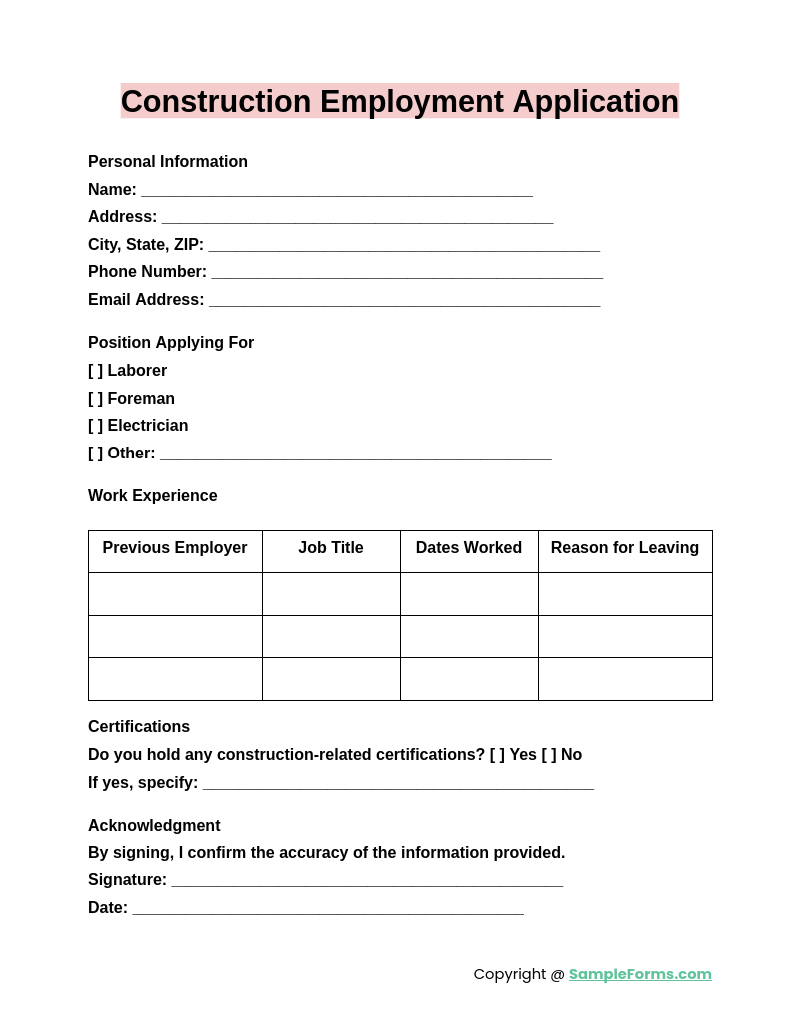
A Construction Employment Application is tailored for hiring skilled laborers and project managers. Comparable to an Employment Physical Form, it may include sections for certifications, physical fitness, and previous construction experience, ensuring safety and competency in the workplace.
Pre-Employment Application
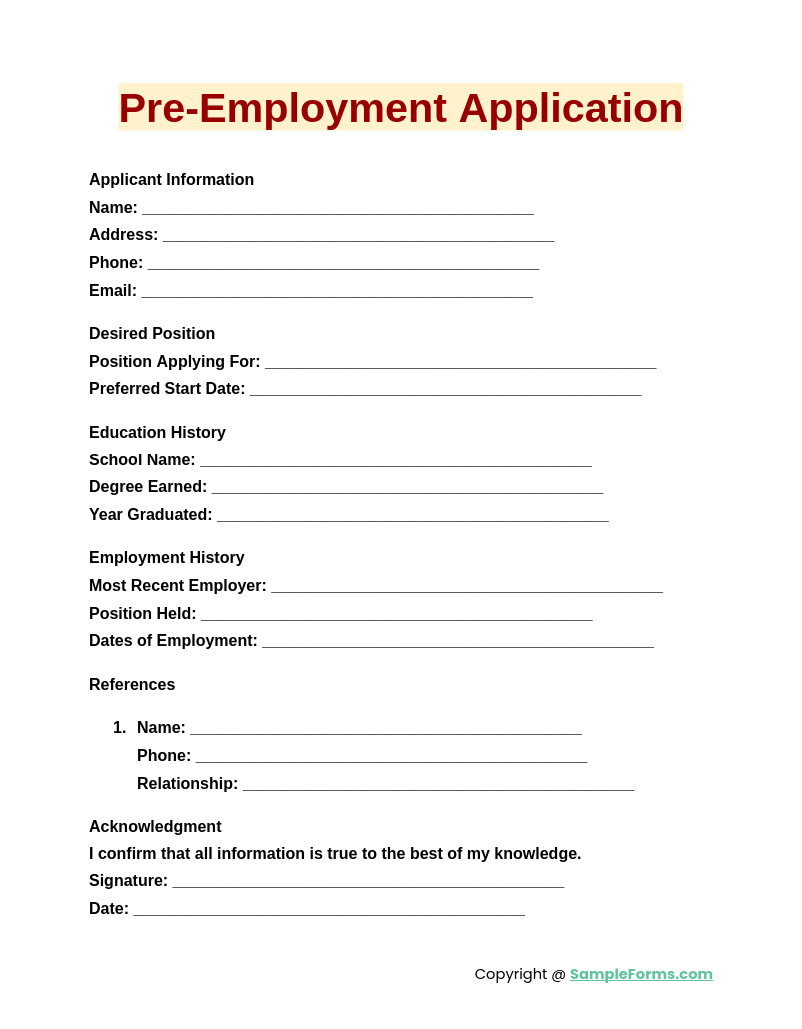
A Pre-Employment Application collects preliminary information to assess candidate suitability before formal hiring. Much like an Employment Verification Request Form, it ensures transparency by including sections for employment history, qualifications, and basic background checks.
Driver Employment Application
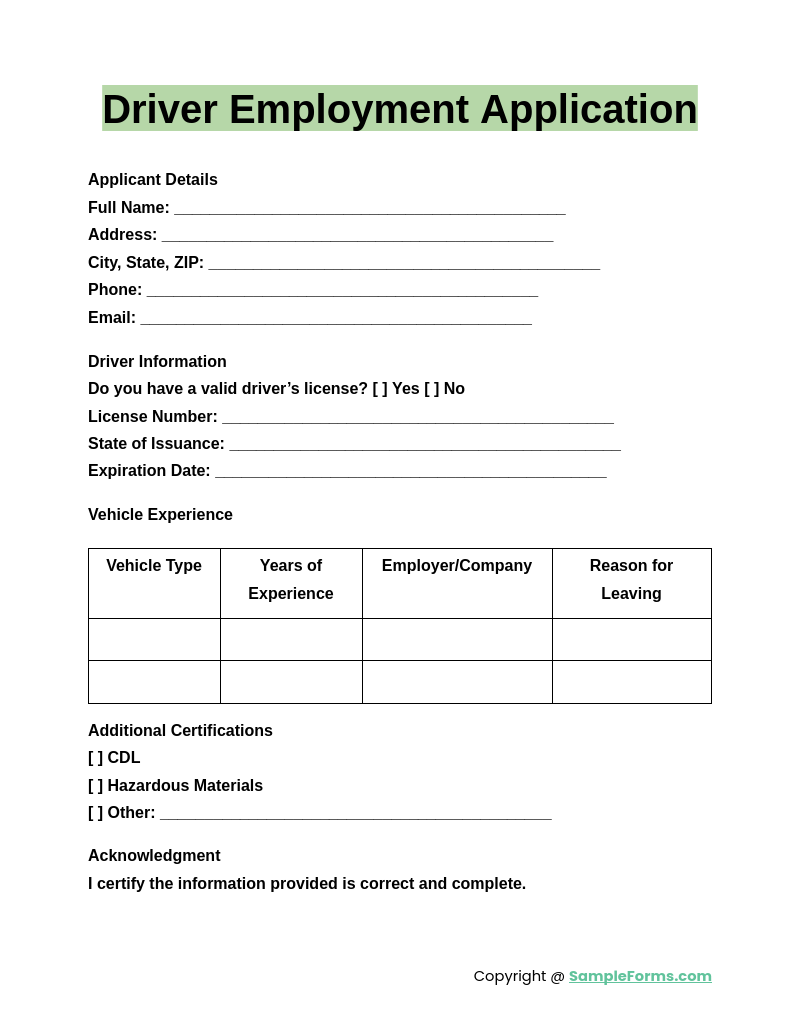
A Driver Employment Application is used to evaluate candidates for driving positions. Similar to an Employment Agreement Form, it includes license details, endorsements, and driving history to ensure compliance and suitability for transportation roles.
Browse More Employment Applications
Generic Sample Employment Application Form
Generic Application for Employment Form in PDF
Generic Printable Employment Application Form
Free Generic Restaurant Employment Application Form
Generic Blank Employment Application Form
Generic Faculty Employment Application Form Format
Generic Retail Employment Application Form Example
Generic Nanny Employment Application Form
Downloadable Generic Store Employment Application Form
Generic Plumbing Employment Application Form
Simple Generic Employment Application Form
How to create an employment application?
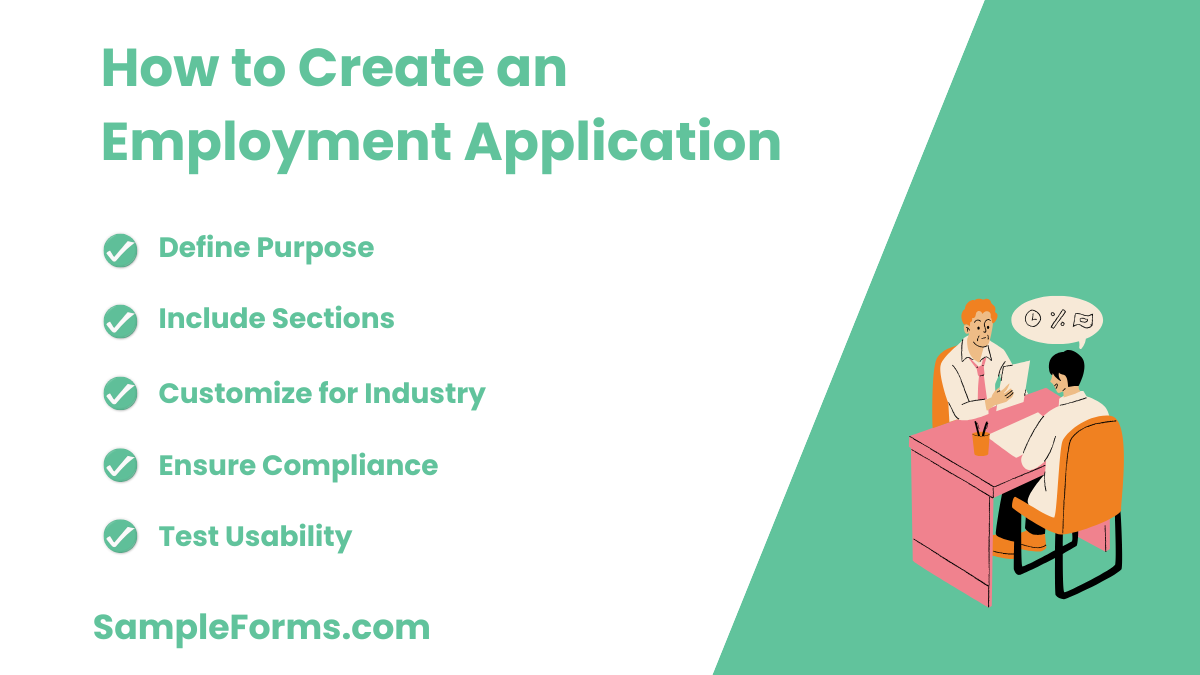
Creating an employment application ensures a standardized process for collecting candidate information. Key steps for developing an effective application include:
- Define Purpose: Clarify the role and requirements, similar to creating an Employment Information Form for detailed candidate data.
- Include Sections: Add fields for personal details, employment history, education, and references.
- Customize for Industry: Tailor the form to the specific job type or sector.
- Ensure Compliance: Align with legal and ethical standards to protect candidate rights.
- Test Usability: Review the application for clarity and ease of use.
What are the steps to applying for employment?
Applying for a job involves several structured steps to ensure accuracy and professionalism. Follow these steps for successful applications:
- Research Opportunities: Find jobs matching your skills, like roles requiring a Restaurant Employment Form for specific positions.
- Prepare Your Resume: Highlight relevant experience and achievements.
- Complete the Application: Fill out the required details accurately and thoroughly.
- Submit Supporting Documents: Include a cover letter or certifications if requested.
- Follow Up: Contact the employer to confirm receipt and express continued interest.
What Cannot be asked on an employment application?
Certain questions are prohibited to ensure fairness and legality in hiring. Employers must avoid discriminatory or irrelevant inquiries, such as:
- Personal Information: Avoid questions about race, religion, or marital status, unlike details in an Employment Agreement for job terms.
- Age: Exclude inquiries that reveal the candidate’s age unless legally required.
- Health Conditions: Do not ask about disabilities or medical history.
- Citizenship Status: Avoid specifics beyond eligibility to work legally.
- Criminal Records: Only ask about convictions if relevant to the role.
What are things to avoid when filling out a job application?
Filling out an application requires attention to detail. Avoid these common mistakes to improve your chances:
- Inaccurate Information: Ensure all details are correct, like when completing a Teacher Employment Form for precise qualifications.
- Incomplete Fields: Leave no section blank unless it’s explicitly optional.
- Generic Responses: Tailor answers to the specific job role and requirements.
- Neglecting Instructions: Follow application guidelines carefully.
- Unprofessional Presentation: Avoid typos or overly casual language.
What information is required on most employment applications?
Employment applications typically gather comprehensive details to evaluate candidate suitability. Required information includes:
- Personal Details: Name, contact information, and address, as seen in an Employment Eligibility Verification Form.
- Employment History: Previous roles, employers, and dates of employment.
- Education: Academic qualifications and certifications.
- References: Contact information for professional references.
- Legal Eligibility: Confirmation of the right to work in the jurisdiction.
How to write an application for employment?
Start by clearly outlining your skills and experience relevant to the role. Use structured templates like an Application for Employment Form for a professional approach.
Do employees need to fill out an employment application?
Yes, completing an Employment Eligibility Form ensures candidates meet legal and job-specific requirements while streamlining the hiring process for employers.
How to make yourself stand out in an application?
Highlight unique skills, tailor responses, and provide measurable achievements, much like customizing an Employment Requisition Form to match job specifics.
How do I start my application?
Begin with personal details and a clear objective statement, similar to the initial sections of an Internship Application Form, for clarity and focus.
What can an employer say in an employment verification?
Employers can confirm job title, tenure, and duties, akin to the specifics outlined in a Pre Employment Physical Form, without disclosing personal details.
Can employers see your job history?
Yes, with your consent, employers can verify past roles and employment, similar to reviewing a Business Application Form for applicant information.
Does employment verification show termination?
Employment verification may disclose termination reasons if authorized, similar to providing details on a Volunteer Application Form for reference checks.
What cannot be on a job application?
Discriminatory or unrelated questions, such as those about race or religion, should not appear, ensuring fairness, like in a Contractor Application Form.
What questions can legally be asked when verifying employment?
Legal questions include job title, dates of employment, and salary, comparable to sections of a Counseling Application Form for structured inquiries.
What does employment verification reveal?
Employment verification confirms job history, tenure, and performance, much like validating credentials in an Employment Renewal Form for re-hiring processes.
The Employment Application is a cornerstone of effective recruitment. It simplifies the hiring process by providing a structured way to collect applicant information, ensuring compliance and facilitating fair evaluation. Tailored to specific job roles, these forms enhance efficiency and maintain professionalism. Whether integrated into digital platforms or used in traditional formats, an Employment Separation Form ensures seamless transitions and documentation in the employee lifecycle. This guide equips you with the tools to create customized employment applications for optimized hiring practices.
Related Posts
-
Job Application Form
-
Internship Application Form
-
Recruitment Application Form
-
FREE 18+ Leave Cancellation Forms Download – How to Create Guide, Tips
-
FREE 6+ Business Credit Checklist Forms in PDF
-
FREE 8+ Commercial Property Application Forms in PDF
-
FREE 6+ Background Check Application Forms in PDF | MS Word
-
FREE 6+ Leasing Application Forms in PDF | MS Word
-
FREE 10+ New Job Application Forms in PDF | MS Word | Excel
-
FREE 9+ Articles Of Organization Forms in PDF
-
FREE 10+ Commercial Rental Application Sample Forms in PDF | MS Word
-
FREE 5+ HR Reclassification Application Forms in PDF | MS Word
-
FREE 8+ Clearance Application Forms in PDF | MS Word
-
FREE 6+ Talent Application Forms in PDF | MS Word
-
FREE 6+ House Rental Application Forms in PDF | MS Word | Excel
